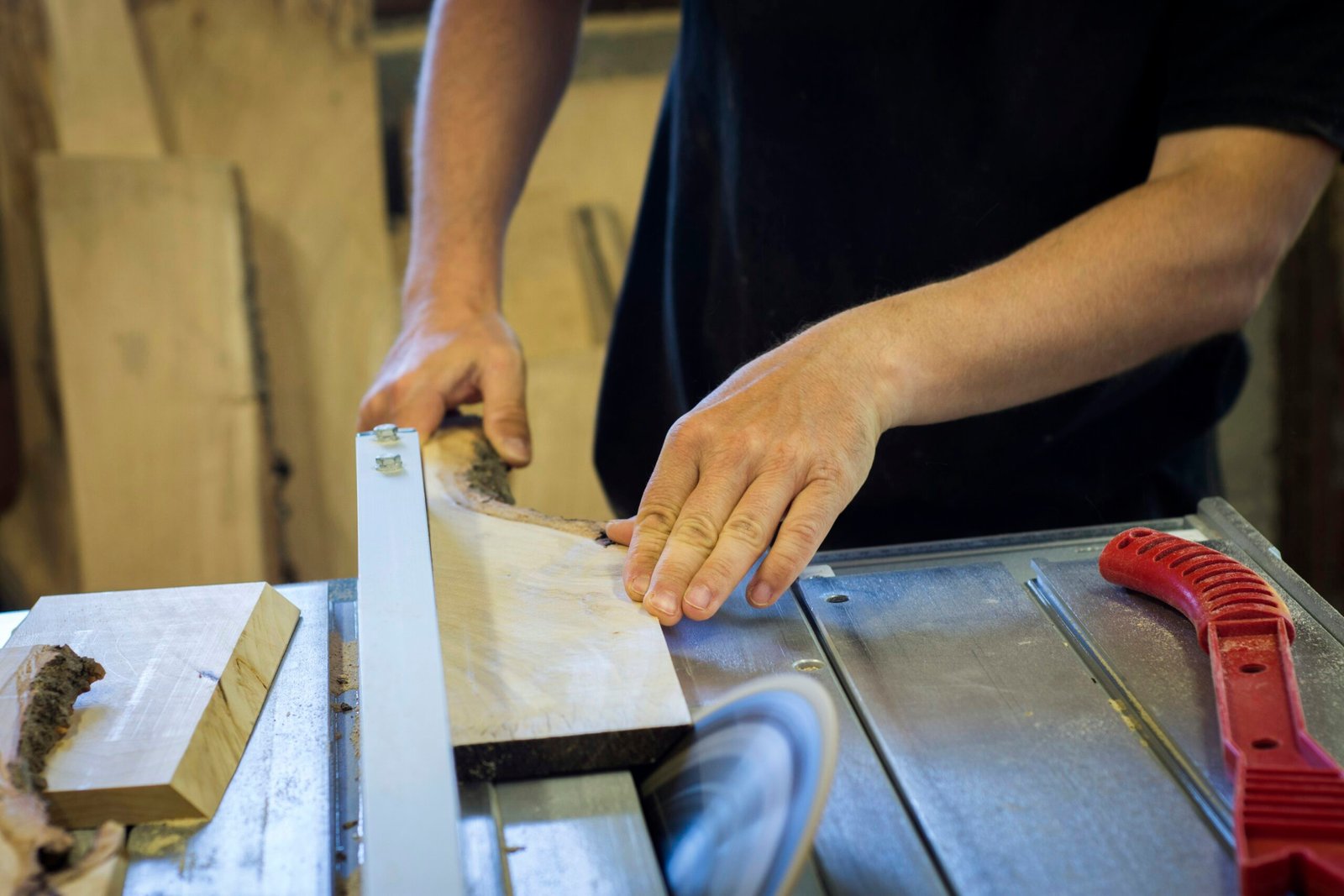A table saw is a versatile woodworking tool that consists of a circular saw blade mounted on an arbor, which is driven by an electric motor. The blade protrudes through a flat surface called the table, allowing woodworkers to make precise cuts in various materials. Table saws are essential tools for both professionals and hobbyists, providing the accuracy and efficiency needed for a wide array of woodworking projects.
In woodworking, table saws are commonly used for making straight cuts, such as rip cuts and crosscuts. Their ability to adjust the blade height and angle enables users to create angled or beveled cuts with ease. This adaptability makes table saws suitable for producing a variety of products, from furniture to cabinetry and intricate designs. Moreover, the use of accessories such as fences, miter gauges, and dado blades further expands the capabilities of a table saw, enhancing its utility in any workshop.
For DIY enthusiasts, investing in a table saw can significantly ease the complexity of home improvement projects, enabling individuals to achieve professional-level results. The precision provided by a table saw allows for cleaner edges and better fitting joints, ensuring that finished projects have a polished appearance. Additionally, for professionals engaged in woodworking as a trade, a table saw is indispensable, often forming the backbone of their shop setup. The speed at which a skilled woodworker can make precise cuts using this tool can greatly improve productivity, allowing for a higher volume of work with superior quality.
In summary, a table saw is not just a simple tool but an essential investment for anyone serious about woodworking. Its versatility and efficiency can elevate both DIY projects and professional craftsmanship, making it a worthy addition to any workshop.
Key Features of a Table Saw
When considering the investment in a table saw, it is crucial to understand the key features that define its performance and efficiency. Among these, blade size plays a significant role; most table saws utilize blades ranging from 10 to 12 inches in diameter, allowing for various cutting depths depending on the material. A larger blade size generally enables deeper cuts and accommodates thicker materials, which makes these saws particularly versatile for woodworkers and professionals alike.
Another vital aspect to consider is motor power. The motor is essentially the heart of the table saw, and it is usually rated in horsepower (HP). A saw with a higher HP will provide more power and better capabilities for cutting dense hardwoods or making precise bevel cuts. Common configurations feature motors ranging from 1.5 HP to over 5 HP, accommodating both hobbyists and professionals with different needs. It’s also essential to consider the motor’s speed, which impacts the efficiency and quality of the cuts made.
Cutting capacity is another fundamental feature of a table saw. This capacity determines how wide and how deep cuts can be made in a single pass. Most table saws provide a rip capacity of 24 inches or more, allowing users to tackle larger sheet goods efficiently. Additionally, the ability to tilt the blade for angled cuts increases the saw’s versatility, enabling a variety of joinery techniques.
Finally, modern table saws prioritize user safety. Key safety features include blade guards, anti-kickback devices, and emergency shut-off switches. Some advanced models also incorporate technology such as flesh detection systems that immediately stop the blade’s motion upon contact with skin. These advancements not only make table saws safer but also enhance the confidence of users during operation, making this essential woodworking tool both powerful and reliable.
Advantages of Using a Table Saw
Investing in a table saw offers numerous advantages that can significantly enhance the woodworking experience. A table saw stands out primarily for its precision cutting capabilities. Unlike many handheld tools, a table saw utilizes a fixed blade with a level, stable surface, which allows for more accurate and consistent cuts. This accuracy is essential for creating intricate designs or when assembling multiple pieces that must fit together seamlessly.
One of the key features of a table saw is its versatility in making various types of cuts. It excels at ripping lumber, a process that involves cutting along the grain, but it is equally proficient in performing crosscutting and bevel cuts. In contrast, handheld saws often struggle with such specific needs, requiring additional adjustments or different tools to achieve similar results. Furthermore, table saws can accommodate larger workpieces, facilitating tasks that would otherwise be cumbersome with other tools.
Moreover, the efficiency of using a table saw cannot be understated. With its appropriate setup, woodworkers can execute multiple cuts in a single pass, significantly reducing the time needed for larger projects. This efficiency is particularly advantageous in professional settings, where time and precision are paramount. While other saws might offer mobility, the stability and power of a table saw allow users to produce cleaner cuts at a faster rate, ultimately resulting in less material wastage.
In summary, when evaluating tools for woodworking, the table saw emerges as a superior choice for both precision and efficiency. Its ability to perform a variety of cuts combined with the accuracy it provides makes it an invaluable asset in any workshop. For keen hobbyists or professional woodworkers alike, a table saw promises to enhance the overall quality and speed of project completion.
Cost vs. Value: Is a Table Saw Worth the Investment?
Investing in a table saw represents a significant financial commitment for both hobbyists and professional woodworkers. Typically, the price range for table saws varies considerably, starting from around $200 for entry-level models and extending up to several thousand dollars for high-end professional machines. Factors influencing cost include the saw’s build quality, size, brand, and features such as fence systems, blade types, and portability. Understanding this financial commitment is crucial for anyone considering purchasing a table saw, as it invites an assessment of both cost and value.
The value of a table saw transcends its initial cost, particularly in terms of longevity and job efficiency. High-quality table saws are engineered to withstand years of heavy use, providing exceptional durability and reliability. When maintained properly, a premium table saw can last decades, making the upfront investment more justifiable when amortized over time. Furthermore, a well-constructed saw can greatly enhance productivity. It can make precise, repeatable cuts more quickly than hand tools or less capable equipment, allowing users to complete projects in less time.
In addition to reducing labor hours, a table saw minimizes material waste. By achieving accurate cuts consistently, it helps ensure that raw materials are utilized effectively, ultimately leading to cost savings. For professionals, the ability to deliver high-quality work promptly can be a crucial factor in securing projects and maintaining a competitive edge. By weighing the cost of a table saw against its longevity and the efficiencies it introduces, it becomes evident that this equipment is not merely an expense but rather a long-term investment that can yield substantial returns over time.
Safety Considerations When Using a Table Saw

When operating a table saw, safety should always be the foremost consideration. Understanding and implementing various safety measures can significantly reduce the risk of accidents, making the woodworking experience both productive and secure. One of the most prominent features to look for in a table saw is the presence of blade guards. These protective shields are designed to cover the blade during use, preventing accidental contact and minimizing the potential for severe injuries. Always ensure that the blade guard is in place and functioning correctly before starting any cutting operation.
In addition to blade guards, kickback prevention is another crucial safety feature that should be prioritized. Kickback occurs when the wood being cut is suddenly thrown back towards the user, posing a significant danger. To counteract this threat, consider investing in a table saw equipped with anti-kickback pawls and a riving knife, which work in unison to keep the material stable as it passes through the blade. Proper alignment and support for the workpiece are also essential in preventing kickback during cuts.
Furthermore, the use of push sticks and operating jigs can greatly enhance safety by keeping hands a safe distance from the blade. Push sticks allow you to guide the wood without risking direct hand contact with the blade. It is advisable to maintain a clean and organized workspace to avoid distractions, which can compromise safety. Regular maintenance checks on the table saw to ensure all safety features are in working order is also highly recommended. By adhering to these safety measures and choosing a high-quality table saw, users can significantly improve safety in the workshop and promote a more enjoyable woodworking experience.
Table Saw Maintenance Tips
Maintaining a table saw is essential for ensuring its longevity, efficiency, and performance. Regular maintenance can significantly enhance the tool’s functionality while ensuring safety during its operation. One of the primary aspects of table saw care is regular cleaning. Sawdust and debris can accumulate on the surface and within the internal workings of the saw, affecting both performance and safety. After each use, it is advisable to clean the table surface, fence, and miter gauge with a soft brush or cloth. Additionally, the internal mechanisms should be periodically checked and cleared of any buildup to prevent malfunction.
Another critical maintenance task is the replacement of the saw blade when it becomes dull or damaged. A sharp blade is vital for clean cuts and efficient operation. Depending on the frequency of use, it is important to inspect the blade regularly for wear and tear. Replacing the blade not only improves cutting performance but also reduces the strain on the saw motor, contributing to its longevity. When changing blades, ensure that you follow the manufacturer’s instructions to guarantee proper fitting and safe operation.
Calibration is equally crucial in maintaining a table saw. Over time, the alignment of the blade and fence may shift, leading to inaccurate cuts. Regularly check the alignment of the blade with the miter gauge and the fence to ensure they are parallel. Utilizing a dial indicator for precise measurement can be beneficial in this regard. A well-calibrated table saw not only enhances cutting accuracy but also prolongs the life of the tool by preventing undue stress on its components. By implementing these maintenance practices—cleaning, blade replacement, and calibration—you can maximize the performance of your table saw and ensure it serves you well for many years to come.
Choosing the Right Table Saw for Your Needs
When considering an investment in a table saw, it is crucial to evaluate several factors to ensure you select the right model that aligns with your specific needs. The type of projects you intend to undertake, your level of experience, and available space will significantly influence your decision. There are three primary types of table saws on the market: contractor, cabinet, and jobsite saws, each offering distinct advantages and disadvantages.
Contractor table saws are a popular choice among woodworkers due to their balance between portability and performance. Designed for versatility, these saws typically feature an open stand that makes them relatively lightweight and easy to transport. They generally possess sufficient power for a wide range of woodworking tasks. However, contractor saws may lack some of the precision and stability offered by more advanced models, which could be a drawback for users requiring exact measurements.
Cabinet table saws are recognized for their robust construction and superior accuracy. Built with heavy-duty components, these saws are ideal for professionals or dedicated hobbyists who frequently engage in high-volume or intricate projects. The enclosed cabinet design helps reduce noise and vibration, resulting in more precise cuts. On the downside, cabinet saws can be quite heavy and less portable, making them better suited for permanent installations in workshops.
Jobsite table saws, as the name suggests, are built for mobility and often feature a compact design, making them suitable for on-site work. These saws typically have folding stands and are lighter, allowing for easy transport. While they are convenient, jobsite saws may sacrifice some cutting power and precision compared to their contractor or cabinet counterparts. Understanding the pros and cons of each type will help you make an informed choice based on your requirements.
Real-Life Applications of Table Saws
Table saws are indispensable tools for both amateur and professional woodworkers, offering unparalleled precision and versatility. One common application is in home improvement projects, where a table saw can be used to cut plywood sheets for kitchen cabinets or bookcases. The accuracy of a table saw ensures that each cut is straight and clean, reducing the need for extensive sanding and fitting afterward.
In woodworking, creating furniture is another area where table saws shine. Whether you are constructing a dining table or a complex shelving unit, the ability to make precise miter cuts and rip boards to exact widths is crucial. Projects such as building a coffee table often involve various wood species, necessitating cuts that a table saw can easily handle with its adjustable blade height and angle settings.
Moreover, table saws play a vital role in advanced woodworking projects, such as cabinetry and custom millwork. Craftsmen can use the saw to create intricate joinery, such as dovetails and finger joints, which require precise cuts for a snug fit. The adaptability of a table saw allows woodworkers to achieve various profiles by employing different blades and jigs, accommodating a wide range of styles and designs. This versatility has made the table saw a staple in professional workshops, where time efficiency and precision directly correlate to the quality of the finished product.
From DIY enthusiasts tackling smaller home projects to skilled artisans engaged in custom woodworking, the applications of a table saw in various scenarios highlight its effectiveness as a crucial tool. Its ability to facilitate a broad spectrum of tasks while maintaining a high level of accuracy makes it an essential investment for anyone serious about woodworking.
Conclusion: The Long-term Benefits of a Table Saw
In the realm of woodworking, the significance of investing in a table saw cannot be overstated. This versatile tool not only enhances the precision and efficiency of cuts but also elevates the overall quality of woodworking projects. Throughout this guide, we have explored the various advantages that a table saw offers, applicable to both hobbyists and professionals alike.
One of the most notable benefits of a table saw is its ability to provide consistent and accurate cuts, a necessity for anyone looking to produce high-quality pieces. Whether you are constructing intricate cabinetry or engaging in simple DIY projects, having the right equipment can make all the difference. The precision that a table saw offers allows users to achieve uniform dimensions, ultimately resulting in a polished final product.
Moreover, the time-saving aspects of a table saw should not be overlooked. With its powerful capabilities, a table saw can significantly reduce the time spent on cutting tasks. This efficiency is particularly beneficial for professionals who have to meet deadlines and require reliable performance. By minimizing the time needed for project completion, woodworkers can focus more on design and creativity, thus enhancing their craftsmanship.
Finally, for those considering their woodworking needs, a table saw serves as an indispensable tool that can accommodate a wide range of projects. Whether one is cutting sheet goods, making repeated cross-cuts, or creating intricate joinery, the versatility of a table saw makes it invaluable in a woodworker’s arsenal. Investing in this tool not only meets immediate project needs but also fosters future growth in woodworking skills and creativity. Hence, it can be an essential asset in achieving both personal satisfaction and professional success in this craft.




